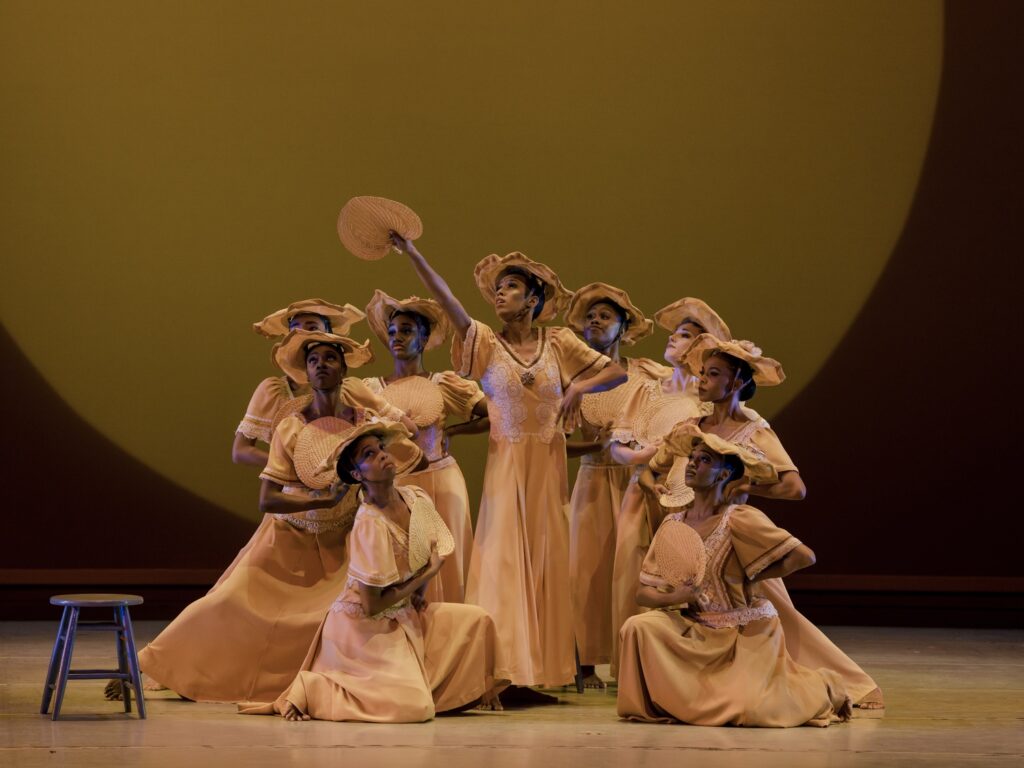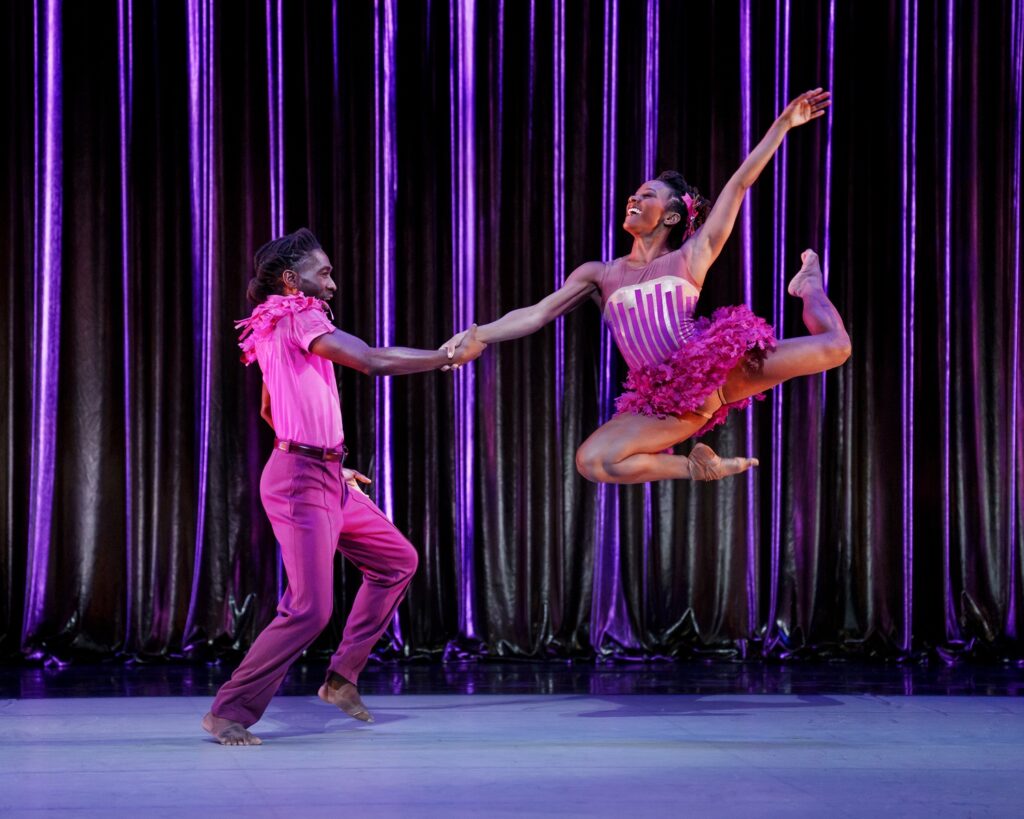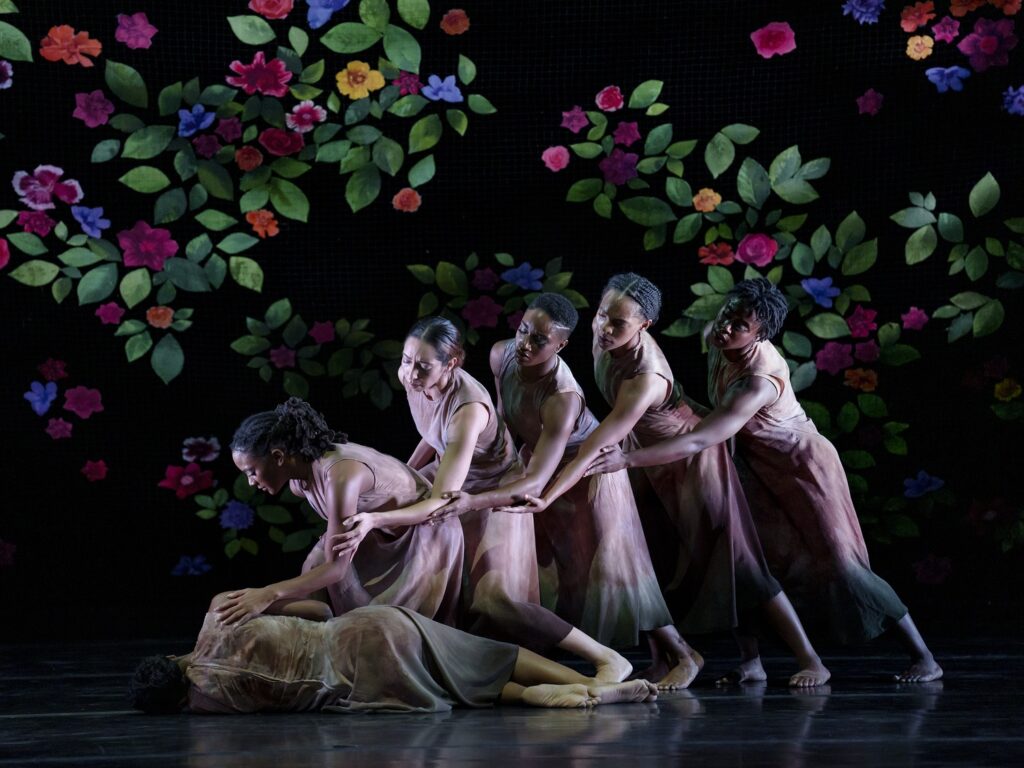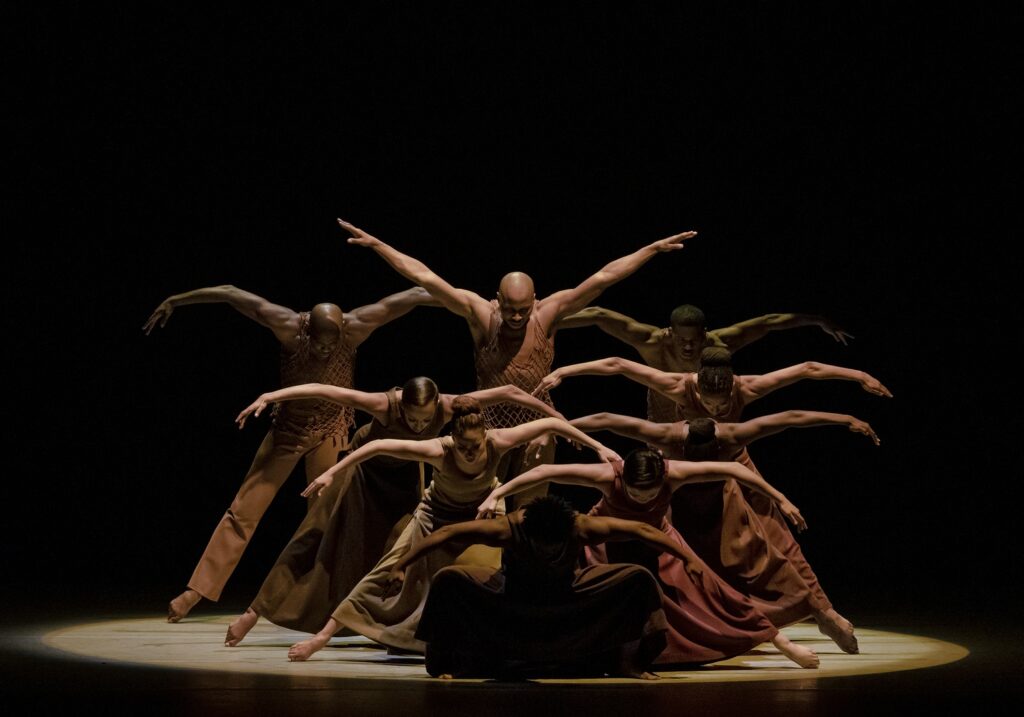
Photos by Paul Kolnik
Alvin Ailey American Dance Theater. Presented by Celebrity Series of Boston. At Boch Center Wang Theatre through May 5.
By Shelley A. Sackett
There is always a special buzz in the air before the curtain rises on an Alvin Ailey American Dance Theater performance, but at Saturday’s matinee, the packed house was positively gaga with anticipation. They were not disappointed. For over two hours, the company thrilled its audience, leaving it enraptured and standing in a deafening ovation.
Presented by Celebrity Series of Boston at the queenly Boch Wang Theatre, five performances offered three programs: “Ailey Classics,” and two programs featuring new productions by other choreographers. All ended with the full production of Ailey’s signature work, Revelations.
“Ailey Classics,” Saturday afternoon’s three-act program, was a brilliant curation of excerpts from eight of Ailey’s jazzy pieces.
The first dance, Memoria, is elegant and delicate. Ailey composed it in 1979 as a tribute to his deceased colleague, Joyce Trisler, and there is an otherworldly translucent quality to his choreography. The curtain rises on a Tiffany blue background, a soloist in a flowing white dress flanked by two male companions in purple pants and billowing white shirts. Keith Jarrett’s abstract “Runes” (Charlie Haden’s bass is delicious) adds to the drama and flow as the ensemble encircles and wanders through the triangle of the three principal dancers. The ghostliness of the costumes, beauty of the movement, and entrancing emotiveness of the soloist leaves the audience tingling.
Movements II and III of Night Creature (1974) change the mood from ethereal to earthbound and earthy. Set to Duke Ellington’s snappy music, this piece featured Constance Stamatiou as a saucy, sexy flapper who sets the tone and commands our attention. Set in the night world of vintage jazz clubs, the piece is playful and steamy, a toe-tapping delight. A large ensemble struts, leaps and slinks through swing and jitterbug dance moves as they toy with each other and the audience. The star-burst finale is Ailey at his most brilliant.

After a brief intermission, a Pu Pu Platter of bite-sized Ailey excerpts maintains the crackle and pop. Pas De Duke (1976) showcases Ellington’s infectious melodies and a charismatic couple, she dressed in a black vest and tight pants, he in a Travolta-worthy white suit. They are synchronicity personified as they cavort in front of a backdrop of pop art bubbles reminiscent of a lava lamp.
The program continues with music that is conducive to narrative storytelling. Maskela Langage (1969; ‘Morolo’ by Hugh Maskela) is based on the music of the South African trumpeter Hugh Masekela. It is set in a bar—but the bar itself is in a kind of no men’s land. There is an element of sadness and despair in the way a hot mama dispassionately lures three men to dance with her. At the time he created the piece, Ailey apparently wanted to draw parallels between the era of South African apartheid and the race-induced violence of 1960s Chicago.
Love Songs (1972; ‘A Song for You’ by Leon Russell) offers an emotional journey through love and longing, set to a song recorded by Donny Hathaway. Side lit against a black screen, the solo dancer is lyrical and poignant.
With For ‘Bird’ — With Love- Excerpts 1 and 2 (1984), Ailey pays tribute to the great Charlie Parker, the now-legendary alto-saxophonist known familiarly as Bird and after whom the jazz club, Birdland, was named.
With a disco ball, a big crowd of exotic dancers clad in sparkling beaded costumes and feathered headdresses, and music by Coleridge-Taylor Perkinson, Ailey magnificently recreates the Harlem jazz scene. The dancers, like characters in a musical number from a vintage era film, seem to emulate Parker’s style, swinging and glamming with smooth ease.
Excerpt 2 is giddy pleasure, with costumes of red jumpsuits, tails and dancing stick, white suits and red dresses. It is color, joy, and the excitement of top-notch dancing.

When Alvin Ailey started in 1958, he envisioned a company dedicated to enriching the American modern dance heritage and preserving the uniqueness of the African American cultural experience. Since then, his troupe has continued for 66 years with only three artistic directors, the most recent (Robert Battle) since 2011. Of its 32-member ensemble, many have been with the company for more than ten years.
Stability and continuity are hallmarks of the Alvin Ailey company. So is ending its performances with Ailey’s 1960 masterpiece, Revelations.
Even before the second intermission was over, the audience was writhing in anticipation. Like concertgoers who want to hear their musical idols sing the hit song they know all the words to, these Alvin Ailey groupies were primed and ready. With the first notes of the hauntingly beautiful spiritual “I’ve Been ‘Buked,” they were clapping. By the time the curtain rose a few moments later, they were cheering loudly.
And for good reason.
Ailey’s classic is a wonderous tapestry of universal themes, emotion, symbolism and — of course — mind-bogglingly exquisite dancing. No matter how many times I have seen it, it never gets old and it never gets boring because I always notice something for the first time. Revelations somehow manages to combine the comfort of greeting an old friend with the delight of discovering something new about them.
Divided into three sections, the 36-minute piece was inspired by Ailey’s “blood memories” of growing up in rural Texas during the American Civil Rights Movement of the 1960s. “Pilgrim of Sorrow” is an appeal to God for relief from sorrow and destitution; “Take Me to the Water” represents baptism and the welcoming to the church as a full member; and “Move, Members. Move” depicts a traditional Southern Baptist church service.
Four pieces in particular resonated on this most recent viewing. “I’ve Been ‘Buked” opens as a mass of dancers fitted together into a fluid triangle that rises and falls, a pulsating, breathing organism. I never cease to be amazed by the “wow” factor of this use of space and bodies and by the grace and plasticity of the dancers’ arms.

“Fix Me Jesus” is a gorgeous duet that ends in a breathtaking arabesque. Three men race around the stage in “Run Sinner Man.” Their muscular moves against a backdrop of pink and red satanic flames heighten the feeling of frenzied entrapment. In “You May Run On,” those delightful fan-flicking congregational women are a swarm of bees, gossiping and forming fluid cliques. Like hens coming home to roost, they carry their milking stools and fans, plopping themselves down whenever and wherever they please. The effect is charming.
Notwithstanding the above, Revelations really is a piece that must be experienced live to be understood and appreciated. Reading (and writing) about it is simply no substitute. Its passion and power are palpable. The choreography, with its thrilling athletic leaps, cheery jubilance and tender pas de deux, is peerless. Its ten individual dances, from “I Been ‘Buked” to “Rocka My Soul in the Bosom of Abraham,” are stand-alone masterworks. Strung together as a story that is both timeless and timely, it is a magnum opus that must be witnessed live — again and again. Just ask anyone who was at the Saturday matinee.
Thanks to the Celebrity Series of Boston, Alvin Ailey American Dance Theater makes an annual visit to Boston. If you missed it this year, promise yourself you won’t make the same mistake in 2025.
For more information, go to www.celebrityseries.org/

